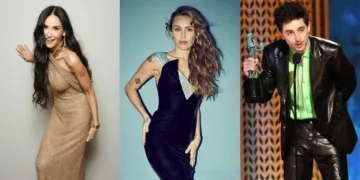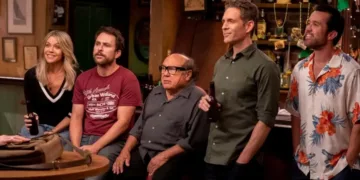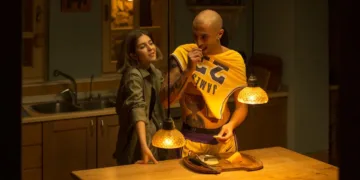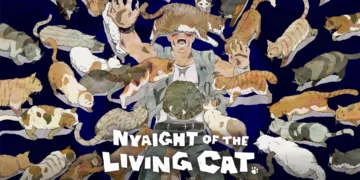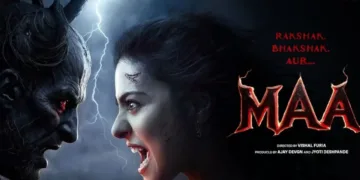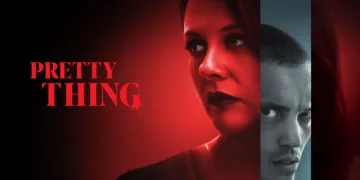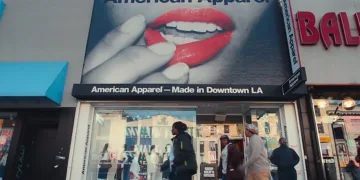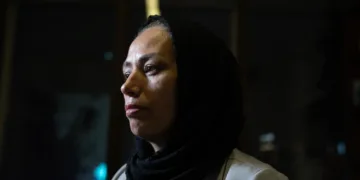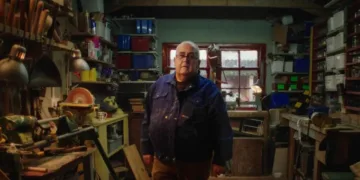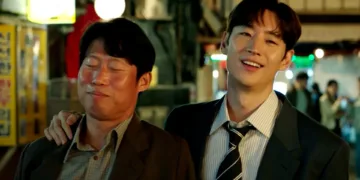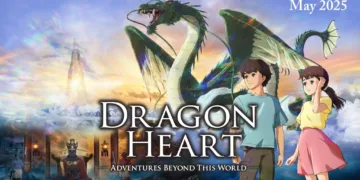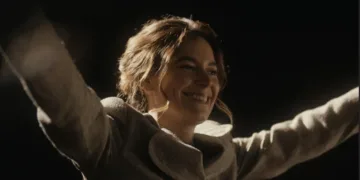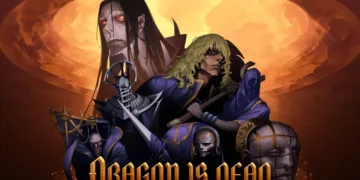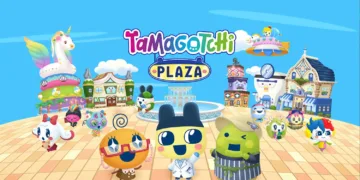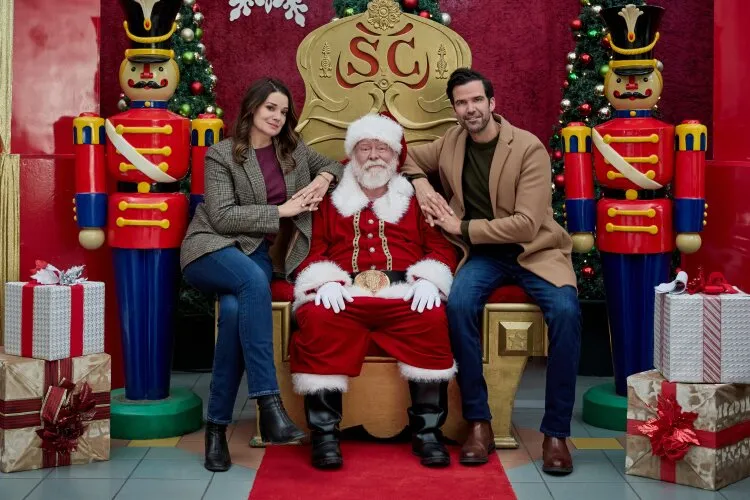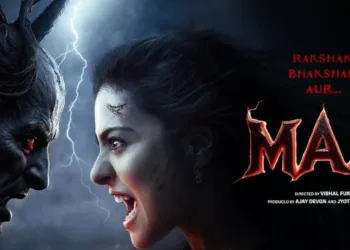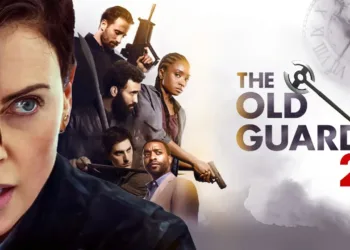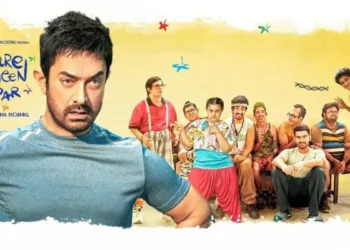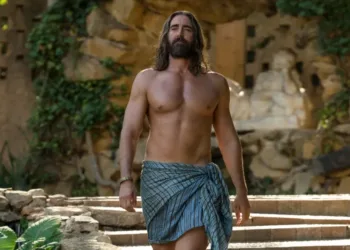In The Santa Class, we are transported to the charming yet hazardous world of the North Star Training Academy for Santas, which serves as a microcosm for larger issues of legacy and ambition. Kate North (acted by Kimberley Sustad with a lovely blend of exasperation and resolve) inherits this struggling institution from her father. This decision reflects the age-old story of familial responsibility vs personal desire. Here, we see the symbolic weight of heredity as the past looms big over Kate’s present, confining her dreams in the same way that jingle bells represent both joy and the load of expectation.
The film depicts a rivalry beyond ordinary competition; the Saint Nicholas School, with its corporate leanings and profit-driven mentality, represents the intrusion of commercialization into the sacred world of holiday spirit. This struggle is about more than just winning the Christmas Cup (though it is a fun subplot); it also addresses the larger societal issue of authenticity vs artificiality in a world increasingly dominated by consumerism.
When Kate and her reluctantly hired former rival, Dan (Benjamin Ayres), discover an amnesiac Santa—who, in a twist reminiscent of It’s a Wonderful Life, symbolizes the very essence of Christmas—the stakes rise above personal ambition. Here, the story invites us to consider what it means to fully live the spirit of Christmas in an age when such principles are frequently forgotten under commercial frenzy.
The amnesiac Santa serves as a potent emblem of lost identity; he represents society’s collective amnesia about the genuine purpose of the holiday season. His quest for self-discovery echoes Kate’s fight to restore her family legacy and a sense of purpose in a world that frequently values the superficial over the meaningful. This interplay of personal and societal narratives provides fertile ground for in-depth contemplation on defining success and belonging in an increasingly fragmented cultural environment.
In many ways, The Santa Class reflects modern culture, forcing us to contemplate what we are prepared to sacrifice for authenticity—an endeavor that is both timeless and critically present.
The Complexity of Christmas: Character Development in The Santa Class
At the heart of The Santa Class is Kate North, a woman battling the weight of legacy and the fragility of dreams. After inheriting the North Star Training Academy from her father, Kate gets caught up in a web of familial expectations and personal disillusionment. She is divided between the urge to honor her father’s vision and the yearning to establish her own path—an existential tug-of-war that many may identify with.
Her internal tension is palpable: Kate is a hesitant custodian of a company that has become a shell of its former self. The battle to keep the school open in the face of financial pressures and the looming threat of corporate competition (play the ominous music from the Saint Nicholas School) serves as a commentary on the larger societal trend of putting profit over passion. In essence, Kate’s journey represents a cultural critique of our time, in which the ‘noble’ pursuit of art (or, in this case, the art of Santa-ing) frequently succumbs to the harsh reality of market pressures.
Then there’s Dan, who transitions between rival and ally with the ease of a well-practiced Santa shimmy. Dan is initially portrayed as a smarmy competitor, yet he experiences a subtle change that defies traditional concepts of rivalry. His relationship with Kate is strained—romantic undertones simmer beneath their arguing, reminiscent of classic romantic comedies in which sparks fly amidst the snark. This dynamic serves as a metaphor for reconciliation, demonstrating how even the most combative relationships may transform into constructive partnerships when the circumstances require it.
The supporting characters at North Star are a wonderful cornucopia of idiosyncrasies, each expressing a different aspect of the holiday spirit (or lack thereof). From the Jewish hippy to the ventriloquist Santa, these characters represent the diversity of holiday experiences, each adding their unique flavor to the training program.
Their unique characteristics not only enhance the comic portions of the film but also contribute to the film’s main theme: the importance of community; in a society that increasingly values conformity, the ragtag bunch at North Star reminds us that true magic is found in our differences—an idea that resonates well with modern culture.
Through the eyes of these people, The Santa Class effectively challenges society’s standards while celebrating the value of individuality and teamwork. Thus, it is both a joyful holiday romp and a profound exploration of identity in a marketed world.
Unwrapping Themes: Family, Competition, and the Christmas Spirit in The Santa Class
The Santa Class functions on several thematic levels, creating a complex tapestry of familial obligation, the pressures of competition, and the quest for genuine holiday spirit. The film’s central theme is Kate North’s struggle with her father’s legacy, which serves as both a blessing and a curse.
She inherits the North Star Training Academy and struggles with the expectation to continue a family heritage while yearning for self-actualization. This conflict mirrors a larger societal quandary: how do we honor our forefathers without compromising our individuality? Kate’s trip exemplifies the classic conflict between the past and the future, a narrative arc reminiscent of many historical personalities who have borne the weight of legacy (think of it as a holiday version of the “great man” thesis, with more cheer).
The Santa Cup’s competitive scene is a microcosm of societal competition in general. What begins as a playful tournament quickly turns into a high-stakes war for survival, mirroring the vicious spirit of modern business culture.
The rivalry with the Saint Nicholas School represents the monetization of tradition, in which ambition frequently trumps joy. Despite this fierce competition, there is hope for redemption—not only for Dan, who transforms from rival to ally, but also for Kate. Their partnership suggests that cooperation may lead to unexpected victories even in a world dominated by competition.
Finally, the film explores the elusive spirit of Christmas, which is more than just commercialism (though there is much of it). The story’s misfit Santa ensemble suggests that Christmas’s essence is community, acceptance, and the joy of giving.
The ragtag crew at North Star, with their eccentricities and peculiarities, serves as a reminder that the actual beauty of the season is found in our shared experiences and connections. In an era when the holiday spirit is frequently diluted by consumer excess, The Santa Class encourages viewers to ponder what it means to celebrate, implying that the best gifts may come not from the mall but from the heart.
Laughter Under the Mistletoe: The Comedy Elements of The Santa Class
The Santa Class successfully uses humor as a narrative device and a cultural commentary, incorporating comic aspects throughout its holiday tapestry. The film’s primary humorous scenarios are frequently based on its basic premise—after all, a Santa school encourages a plethora of absurdities.
One notable scene shows Kate and Dan attempting to handle the complexities of Santa training while overseeing a motley group of aspiring Santas. Their first encounter with the amnesiac Santa (whom they lovingly refer to as “Nick”) is replete with comedic potential, as the perplexed figure exudes a blend of perplexity and charm that sets the tone for the ensuing laughter. The sheer lunacy of training for a role that many equate with good cheer becomes a source of humor that resonates with anyone who has experienced the absurdity of corporate training sessions.
The banter between Kate and Dan is remarkable, providing a humorous lifeline amidst the film’s more serious themes. Their interactions alternate between lighthearted barbs and genuine moments of connection, creating an authentic and engaging dynamic. This interplay exemplifies a classic romantic comedy cliche in which glib repartee conceals deeper emotional realities. Their interactions are filled with dry humor that captures the essence of two people navigating their tangled pasts while attempting to save a failing school—a scenario that is both realistic and wildly hilarious.
Physical comedy is important to the film’s humor, particularly during the training montages, where the wannabe Santas confront more ridiculous challenges. These sequences are reminiscent of classic slapstick, with actors tripping through obstacle courses and mispronouncing “Ho Ho Ho” in ways that will make even the most stoic holiday watcher laugh. The mistakes, ranging from wardrobe malfunctions to awkward meetings with youngsters at the mall, serve as a funny reminder that chaos frequently reigns supreme in the pursuit of perfection (or a perfect Santa).
This blend of situational humor, smart speech, and physical shenanigans entertains and emphasizes the film’s core issues. It urges viewers to chuckle at life’s absurdities while gently implying that accepting our flaws—much like the ragged gang of Santas—may be the key to finding joy throughout the holiday season. In a world that frequently pressures us to comply with idealized norms, The Santa Class provides a refreshing perspective: sometimes, the most real moments come from our delicious mistakes.
The Art of Performance: Chemistry and Camaraderie in The Santa Class
The performances in The Santa Class are a charming blend of charm and comedic prowess, notably the dynamic between Kimberley Sustad and Benjamin Ayres. Sustad’s portrayal of Kate North captures the character’s internal conflict with a delicate touch that alternates between exasperation and determination.
Her comedic timing is great, and she frequently finds humor in the absurdity of her situation—a woman faced with not only operating a Santa school but also dealing with her expectations. Ayres’ performance as Dan compliments her perfectly. Their chemistry is evident, and their lighthearted rivalry develops into a witty and artful partnership. (One could even call it a “romantic rivalry,” which is ripe for examination in the genre of holiday flicks.)
The supporting cast merits recognition, notably Paul Campbell’s self-referential cameo. His inclusion is a charming homage to Hallmark’s star-studded legacy, and his comic remarks about his career provide a layer of meta-humor that enhances the film. Campbell’s ability to play on the absurdity of his situation—being in a Santa training program—contrasts the protagonists’ more genuine performances.
Overall, the performances lift the film from conventional holiday entertainment to a commentary on the nature of ambition, competition, and the quest for belonging, all while keeping a lighthearted tone. The interplay among the ensemble weaves a tapestry of humor and heart, making The Santa Class a wonderful holiday film.
Crafting a Holiday Vision: Production Quality in The Santa Class
The Santa Class immerses viewers in a visually festive environment that captures the warmth and fun of the holiday season. The cinematography uses vivid colors and gentle lighting to create a pleasant, almost dreamlike quality—think of it as a sugar-coated postcard from the North Pole, where every frame begs viewers to suspend disbelief and embrace the enchantment of Christmas (also known as “holiday escapism” at its finest).
The North Star Training Academy’s set design is a lovely ode to the Christmas spirit, with dazzling lights, huge decorations, and many Santa-themed stuff. This great attention to detail serves not only to create a fanciful scene but also to represent the narrative’s broader themes of optimism and renewal.
The film’s style is further enhanced by character costumes, with each Santa trainee wearing attire that reflects their distinct personalities—whether it’s the hippy Santa in tie-dye or the grandmotherly figure as Mrs. Claus. These choices underscore the film’s message about the importance of individuality and community, celebrating the importance of holiday customs. Overall, The Santa Class’s production quality perfectly complements its themes, creating a compelling backdrop that resonates with audiences looking for humor and heart over the holiday season.
A Festive Delight: Conclusion and Recommendation
The Santa Class emerges as a fun romp through the difficulties of holiday pleasure, integrating humor with poignant issues in a way that truly resonates with audiences.
Its delightful characters, funny language, and colorful images make for an interesting viewing experience for those looking for laughter and introspection. The film expertly criticizes conventional norms while celebrating individuality, making it more than a holiday distraction.
I wholeheartedly suggest The Santa Class to anyone searching for a heartwarming holiday film that captures the season’s spirit. It’s ideal for comfortable nights in or family gatherings. Accept the absurdity and let the laughter flow!
The Review
The Santa Class
The Santa Class is a welcome addition to the holiday genre, expertly combining humor with profound legacy, competition, and community themes. With engaging performances, a whimsical style, and a witty indictment of society's expectations, it captures the essence of what makes the holiday season unique. While it may tread similar material, the film's charm and warmth make it a joy to see. It is ideal for individuals who want both laughter and a heartwarming message.
PROS
- Charming performances, especially by Kimberley Sustad and Benjamin Ayres.
- Engaging humor that blends wit with holiday spirit.
- Vibrant visuals and set design that create a festive atmosphere.
- Thoughtful themes about legacy and individuality.
- Strong supporting cast that adds depth to the narrative.
CONS
- Some plot elements feel predictable or formulaic.
- A few comedic moments may not land for all viewers.
- The film sometimes leans heavily on holiday clichés.


















